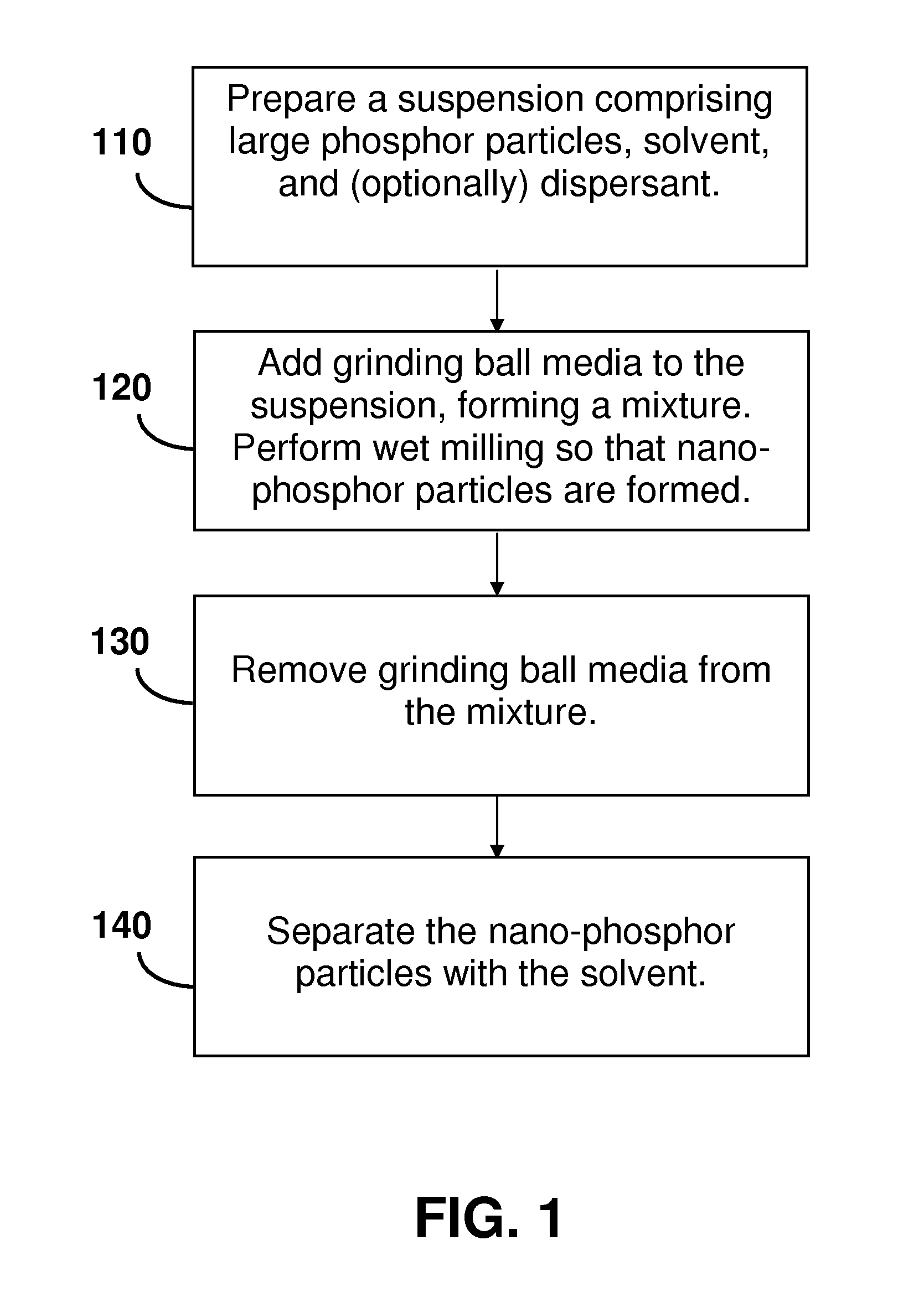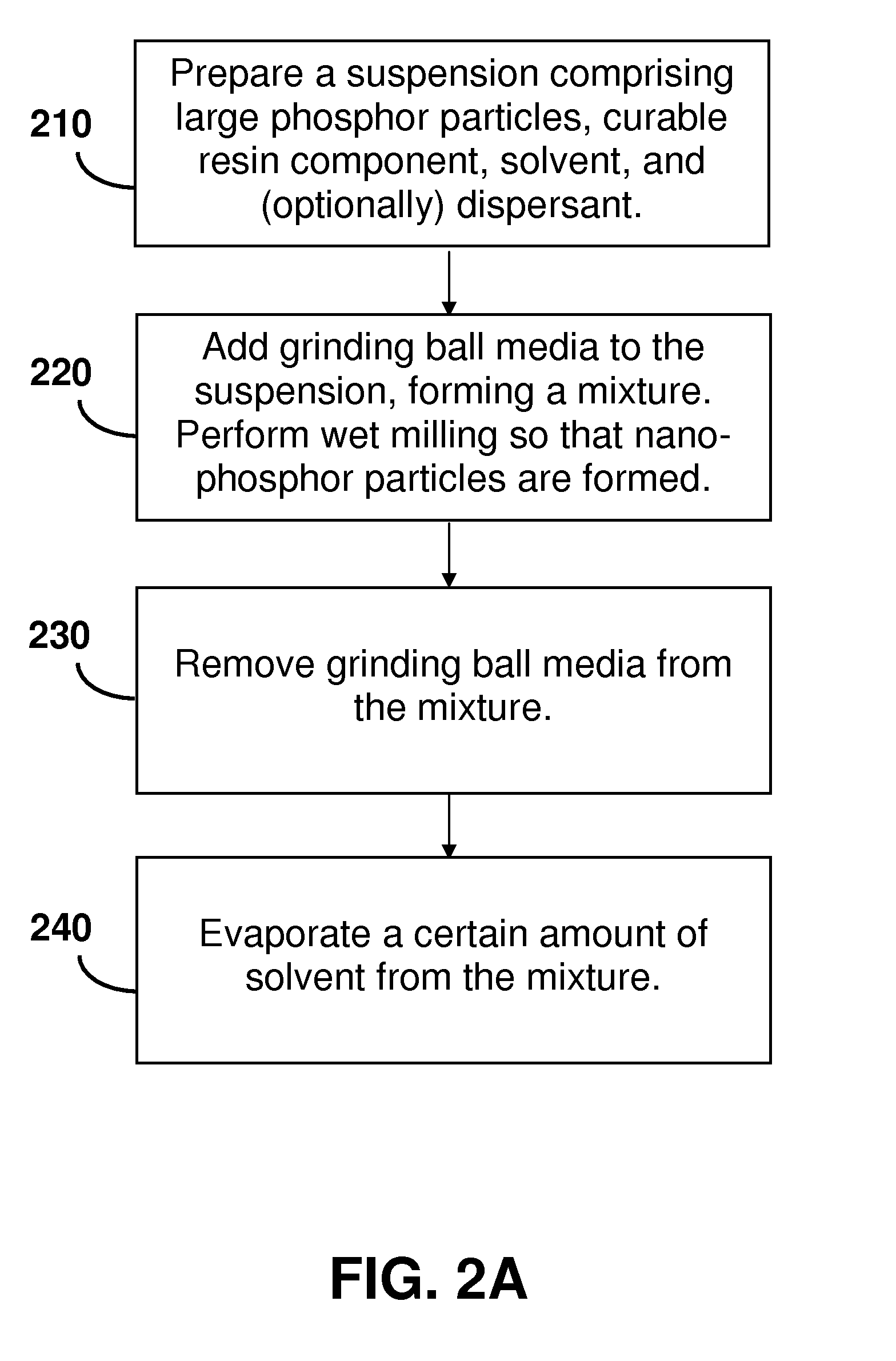Phosphor ink composition
a technology of phosphor ink and phosphor particles, which is applied in the field of phosphor inks, can solve the problems of loss of light conversion efficiency of nano-sized phosphor particles, and is not achievable by other existing nano-sized phosphor particles, and achieves the effects of low cost, low cost, and high light conversion efficiency
- Summary
- Abstract
- Description
- Claims
- Application Information
AI Technical Summary
Benefits of technology
Problems solved by technology
Method used
Image
Examples
example 2
[0047] Add 1 g of YAG:Ce (bulk phosphor) and 99 g of Dow Corning 6550 (curable resin) to 200 cc of acetone (solvent) to form a suspension. Grinding ball media are then added to the suspension to form a first mixture. The first mixture is performed with wet milling until a substantial portion of the bulk phosphor particles have been converted to nano-sized particles. A small sample of the first mixture is removed and subjected to particle size measurement to detect and ensure that most of the bulk phosphor particles are converted. After wet milling, the first mixture is filtered with a screen mesh, to remove the grinding ball media from the first mixture, thereby forming a second mixture. Let all the solvent in the second mixture evaporate and get the final nano-sized phosphor ink formulation for the drop dispense method.
[0048]Example 3: Add 60 g of TAG:Ce (bulk phosphor) and 40 g of Dow Corning 6551 (curable resin) to 200 cc of acetone (solvent) to form a suspension. Grinding ball m...
example 4
[0049] Add 54 g of YAG:Ce, 6 g of Ca-α-SiAlON:Eu (both constituting the bulk phosphor), 25 g of Shin-Etsu 9022 (curable resin) and 15 g of Tego 655 (dispersant) to 200 cc of acetone (solvent) to form a suspension. Grinding ball media are then added to the suspension to form a first mixture. The first mixture is performed with wet milling until a substantial portion of the bulk phosphor particles have been converted to nano-sized particles. A small sample of the first mixture is removed and subjected to particle size measurement to detect and ensure that most of the bulk phosphor particles are converted. After wet milling, the first mixture is filtered with a screen mesh, to remove the grinding ball media from the first mixture, thereby forming a second mixture. Let all the solvent in the second mixture evaporate and get the final ink formulation for the drop dispense method.
[0050]Example 5: Add 30 g of YAG:Ce (bulk phosphor) and 3 g of Zetasperse 2100 (dispersant) to 200 cc of aceto...
example 9
[0057] Add 10 g of YAG :Ce, 1 g of Sr2Si5N8:Eu (both constituting the bulk phosphor), and 3 g of Zetasperse 2100 (di spersant) to 300 cc of 1-pentanol to form a suspension. Grinding ball media are then added to the suspension to form a first mixture. The first mixture is wet-milled until it is detected, by particle size measurement on a small sample of the first mixture, that a substantial portion of the bulk phosphor particles have been converted to nano-sized particles. Afterwards, the grinding ball media are removed from the first mixture by filtering with a screen mesh, to form a second mixture. At this stage, 8 g of Tego 2200 (the curable resin component) and 0.4 g of UV Initiator are added to and well dispersed with the second mixture to form a third mixture. Let part of the solvent in the third mixture evaporate such that the remaining solvent has a weight of 77.6 g, and get the final nano-sized phosphor ink formulation for the ink-jet printing method.
PUM
| Property | Measurement | Unit |
|---|---|---|
| size | aaaaa | aaaaa |
| viscosity | aaaaa | aaaaa |
| size | aaaaa | aaaaa |
Abstract
Description
Claims
Application Information
 Login to View More
Login to View More - R&D
- Intellectual Property
- Life Sciences
- Materials
- Tech Scout
- Unparalleled Data Quality
- Higher Quality Content
- 60% Fewer Hallucinations
Browse by: Latest US Patents, China's latest patents, Technical Efficacy Thesaurus, Application Domain, Technology Topic, Popular Technical Reports.
© 2025 PatSnap. All rights reserved.Legal|Privacy policy|Modern Slavery Act Transparency Statement|Sitemap|About US| Contact US: help@patsnap.com



